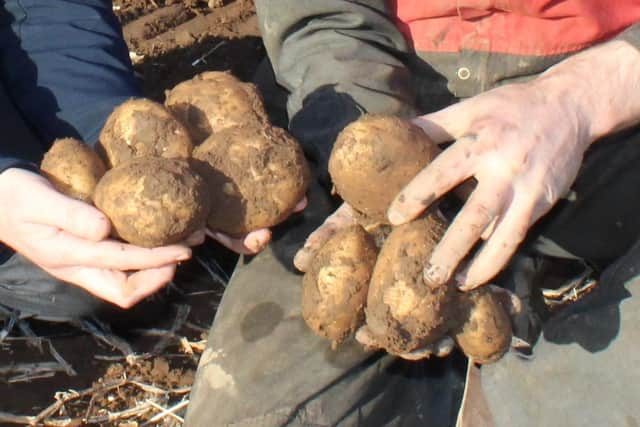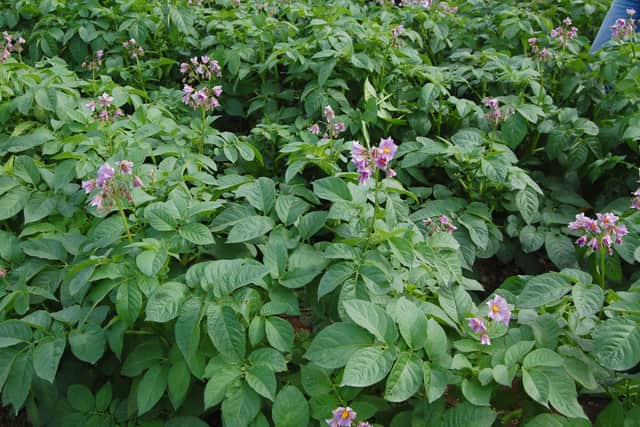The scourge of late blightin potato crops
and live on Freeview channel 276
The disease is responsible for £1,000,000,000 of annual losses in the EU alone.
Across the island of Ireland it is estimated that £5.5 million is spent annually on fungicides to mitigate the impacts of the disease, which represents between 15-20 fungicide applications per season.
Advertisement
Advertisement
Given our climatic conditions during the summer months where such preventative measures are not applied losses of up to 100% can be experienced.


Currently the Irish P. infestans population is dominated by three distinct genotypes. By understanding how these genotypes interact with their environment, it is possible to develop novel disease control measures to minimise blight’s impact upon potato crops.
Unfortunately populations of P. infestans never remain static and the potential for either migration of new genotypes into Ireland or the development of sexual progeny within Ireland poses real threats to the future success of current control strategies. To ensure such changes are detected the population is monitored on an annual basis.
This entails the molecular and phenotypic characterisation of Irish P. infestans strains collected from all possible sources: farmers, allotments, home gardens etc.
Advertisement
Advertisement
Blight is a master at adapting to its environment, it has an ability to complete its life cycle in less than five days. This is a major advantage to a pathogen that is subject to a barrage of different stresses (e.g. heavy fungicide use).


This is most evident in relation to its ability to overcome resistant varieties and/or fungicides. Using the Irish P. infestans collections (both DNA and culture) available at Oak Park changes in specific genotypes can be monitored over a period of 20 years.
This also allows the retrospective detection of such changes which can provide a greater understanding of the genetic mechanisms blight employs to do what it does best: destroy plants.
While fungicide sprays are effective at controlling late blight, they come at a cost: both in actual terms and their impact on the environment.
Advertisement
Advertisement
Recent Irish research has confirmed that combining a cisgenic blight resistant potato with advanced Integrated management systems can reduce the environmental impact of potato production by over 95%.
As part of the EU funded ‘AMIGA’ project and in collaboration with Wageningen University, Teagasc looked at issues such as the efficacy of disease control and the resulting environmental impact during cultivation of a susceptible potato variety (Désirée) and two different resistant potato varieties: Sarpo Mira, developed through conventional breeding, and a resistant version of the Désirée which received a resistance gene from a wild potato through cisgenesis.
Cisgenesis allows enrichment of existing potato varieties in as little as three years versus current potato breeding programmes that require 12 years or more to produce a novel variety.
After undergoing independent peer-review, the findings from three years of field evaluations have been published in the scientific journals European Journal of Agronomy and BMC Ecology.
Advertisement
Advertisement
The research, conducted in both The Netherlands and Ireland, has concluded that integrated production strategies that include varieties with enhanced genetic resistance against late blight disease can reduce the average fungicide input by 80-90%, without
compromising control efficacy or yield. This can provide more durable control options for farmers while significantly reducing the crop’s environmental footprint.
The international team developed an ‘IPM2.0’ approach which includes late blight resistant varieties and builds on the preventive principles of Integrated Pest Management. IPM2.0 could permit growers to strongly reduce the necessary input of chemical control agents. It also ensures a yield equivalent to current practise, protects the limited natural germplasm used to create the resistant varieties and significantly reduces the environmental impact of potato cultivation as a whole.
The IPM2.0 approach adds three extra components to the current control strategy for potato late blight: the use of resistant varieties, active monitoring of the late blight pathogen and a ‘do not spray unless’ strategy, which dictates that a grower only needs to apply fungicides when a resistant variety is at risk of infection due to pathogen adaptation.
Advertisement
Advertisement
This strategy ensures potato crops are protected at all times while minimising the risk that resistance genes lose their efficacy.
The internationally recognised and publicly available Environmental Yardstick for Pesticides was used to quantify environmental impact. Based on this the late blight susceptible variety Désirée cultivated under common practice received more than 700 environmental impact points. The same variety cultivated under IPM2.0 reduced this score to circa 400 points.
Both resistant varieties however scored much better under IPM2.0: cultivation of Sarpo
Mira received an annual average of only 40 points, while the cisgenic resistant version of Désirée scored less than ten points.
Advertisement
Advertisement
Additional environmental investigations examined populations of soil nematodes, which play a key role in soil processes with alterations in the nematode community structure having the potential to considerably influence ecosystem functioning. In effect, fluctuations in nematode diversity and/or community structure can be gauged as a ‘barometer’ of a soil’s functional biodiversity.
Based on the metrics studied, the cultivation of the cisgenic potato variety had no significant effect on nematode community diversity or structure, compared to the non-engineered control variety. In contrast, significant differences were identified between each year of the study due to fluctuating climates and also between the varieties studied due to different plant structures.
In parallel to the active research programme, project staff completed over 95 knowledge transfer events across the country in support of the public discussion on the challenges facing future potato production and the costs/benefits of potential solutions.
But talk of genetically modified crops can have a negative impact on consumer buying patterns.
Advertisement
Advertisement
So what about the option of making more efficient use of fungicides when it comes to controlling blight.
This would be taking place against the backdrop of a major displacement in blight strains taking place across Ireland at the present time.
Teagasc potato specialist Dr. Stephen Kildea described this process as being of a comparable significance to a similar transformation that took place back in 2010.
He commented:“Back then, the new strains of blight created significant challenges for potato growers.
Advertisement
Advertisement
“This time around, the prevalence of a new blight strain, EUA372, is creating significant concern within the potato sector. This is because it has significant resistance to the fungicide, fluazinam.
“This development will have a major impact in terms of how growers manage their potato crops into the future.”
Kildea added:“Being able to predict the impact of possible blight periods is critically important.
“The best example of this relates to the blight strain, Blue 13. This was initially identified in 2008.
Advertisement
Advertisement
“Prior to this we had quite a stable blight population in Ireland. Blue 13 brought with it a resistance to the fungicide metalaxyl. So, straight away, growers had to come up with new prevention strategies.
“It is in this context that effective blight prediction becomes so important.”
According to Kildea, the new blight prediction service available from Met Éireann, which was developed in conjunction with Teagasc, is helping to deliver a much more effective disease risk evaluation service.
He said:“I think it’s a case of growers getting used to the new service. It has been designed to quantify the level of risk posed by a specific blight period. In turn, this allows growers to tweak the actual quantities of fungicide that they apply.
Advertisement
Advertisement
“Prolonging the intervals between sprays is another option that farmers can now look at.
“But it’s very much a case of a grower knowing the actual location of their crops, the varieties they are growing and then using the new prediction service to develop their specific blight control programmes.”
Meanwhile, Met Éireann is playing a central role in the development of new blight control strategies for all Irish potato growers.
The organisation’s Dr. Klara Finkele explained that weather modelling and blight prediction services go hand-in-hand.
Advertisement
Advertisement
She confirmed that Met Éireann has been providing farmers across the island of Ireland with a blight prediction service for the past 60 plus years.
However, field studies which investigated the occurrence of blight under different weather conditions found that the so called ‘Irish Rules’ were not as accurate as they could be, with the old model being overly conservative, missing the onset of outbreaks and failing to warn of blight outbreaks when they occurred.
These failings led to the model being recently updated to reflect the latest science.
The new method reduces the threshold for relative humidity from 90% to 88% and the initial (sporulation) period from 12 hours to 10 hours, the analysis also showed temperature thresholds for blight epidemics could be changed from 10°C to 12°C.
Advertisement
Advertisement
Though risk estimation has increased compared to the previous rules, estimated chemical usage is still lower compared to standard grower’s practice. The new methodology is now referred to as the ‘New Irish Rules.’
“These changes were agreed courtesy of a joint Teagasc: Met Éireann research project,” confirmed Finkele.
“Met Éireann subsequently introduces the new rules in line with the results of the research work that has been undertaken.”
Stephen Kildea explained that the development of late blight prediction models had been an obvious priority for the potato industry for some time, adding:“The original prediction service was extremely conservative in nature, and would have only flagged-up high blight pressure situations.
Advertisement
Advertisement
“But it was missing other periods when blight could have caused considerable damage to potato crops.
“By adding in new variables and tweaking a number of the existing parameters, we now have a blight forecasting service that is more fit for purpose under Irish conditions.”
According to Kildea, the research undertaken to come up with the new blight prediction model included Teagasc field trials, which also factored-in issues such as varietal resistance.
Significantly, this work has indicated that the New Irish Rules can significantly reduce the total amount of fungicides applied while controlling the disease.
Advertisement
Advertisement
Teagasc’s head of crops’ knowledge transfer, Michael Hennessy, Hennessy confirmed that his organisation remains committed to a vibrant potato development research programme.
He added: “Developing new varieties that are resistant to Potato Cyst Nematode, or PCN, is a key focus of the work ongoing at Oak Park,” said Hennessy.
“The development of the new variety Buster is extremely exciting in this regard. It is resistant to both species of P Climate change, reducing pesticide use and feeding an expanding global population presents a lot of challenges for potato breeders.”
Currently, Teagasc research scientists are focussed on developing potato varieties that are resistant to drought, as well as a range of important diseases affecting potato crops.
Advertisement
Advertisement
But developing potato crops that are inherently resistant to blight remains the holy grail for the sector.
“But this is a bit like shooting at a target that is constantly moving,” stressed Michael Hennessy.
“The reality is that the various blight strains are forever mutating.”